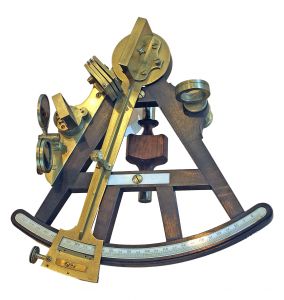How Does a Sextant Work?
A sextant is an optical instrument for measuring the altitude, or angle of elevation, of a celestial body. It was invented independently by Thomas Godfrey, an American, and John Hadley, an Englishman, in 1730. The sextant derives its name from the fact that some instruments had a metal-frame arc of one sixth of a circle, or 60°. The instruments now are built with arcs of different degrees, but all of them commonly are called "sextants." Occasionally, the terms "octant," "quintant," or "quadrant" now are used for instruments having arcs of 45°, 72°, and 90°, respectively.
The sextant originally was used in marine navigation to help determine the position of a ship at sea. It still is used for this purpose, and in addition, it now is used in helping to determine the position of an airplane. Sextants used in air navigation differ significantly from those used in marine navigation. Consequently, modern instruments are grouped in two classes: marine sextants and air sextants.

Marine Sextants
A marine sextant has a frame on which the other parts of the hand-held instrument are mounted. The arc portion of the frame has graduations marked in degrees. The index arm, moved by hand, is pivoted about the center of curvature of the graduated arc. The index mirror, mounted at the upper end of the index arm, rotates clockwise when the index arm is moved clockwise. The horizon glass is mounted in a fixed position on the frame, and at zero reading on the graduated arc the horizon glass and the index mirror are parallel. The horizon glass, which is viewed through the telescope, has a left half that is clear glass and a right half that is a mirror.
The light from a celestial body is reflected from the index mirror to the horizon-glass mirror, which in turn reflects this light into the telescope. The light from the horizon travels on a straight path through the clear glass part of the horizon glass and into the telescope. Filters in both light paths reduce light levels that would cause discomfort to the person looking through the telescope.
An observer determines the altitude of a celestial body by first holding the sextant frame in a position as nearly vertical as possible. He then uses the telescope to view the sea horizon through the clear glass part of the horizon glass, thereby establishing that the telescope is horizontal. The observer then moves the index arm along the graduated arc until the image of the celestial body is seen in the mirror portion of the horizon glass. Next, the observer rotates the micrometer drum until the bottom of this image is in line with the sea horizon. At that moment, the sextant scale reading and the precise time are recorded by the observer. By making two or more similar observations of a celestial body and by using data in navigation almanacs, the observer can determine the latitude and longitude of the ship's position.
Air Sextants
An air sextant performs the same function as a marine sextant but differs from the latter in significant ways. On an airplane, the natural horizon is very seldom visible for use as a reference line in celestial navigation. Therefore, a bubble level or some other gravity-responsive device is built into the optical system of the sextant to serve as an artificial horizon. However, a gravity-responsive device also responds to accelerations of the airplane, even in straight and level flight. These accelerations result in momentary deviations of the bubble reference from the true vertical. Consequently, a single observation could be in error by as much as 150 miles (240 km). Therefore, several observations are averaged by mechanical means over a period of one or two minutes. Under normal flying conditions, this procedure gives a position that is accurate to within about 5 miles (8 km).
Most modern air sextants are periscopic. This form is demanded because the speed and altitude of modern aircraft deprive the crew of observation domes. The periscopic sextant can provide observations from about -10° to +92° of altitude of a celestial body through 360° in azimuth. These observations are made through a 1.375-inch (35-mm) diameter tube that extends 1.5 inches (38 mm) above the skin of the airplane.
The sextant is kept in a gimballed mount attached to the airplane. This mount gives the periscopic sextant a unique advantage over any hand-held sextant in that the former is capable of positive azimuthal positioning. With a rotat-able compass rose in the mount, the periscopic sextant can be used to measure relative bearings and thus can check the aircraft magnetic compass by obtaining the true heading.
In an air sextant, an index prism performs the same function as the index mirror of the marine sextant. The index prism is rotatable, and its angle indirectly indicates the altitude of a celestial body. A knob controls the prism rotation and is coupled to a counter, which gives the altitude of the celestial body directly in degrees and minutes.
The light from the celestial body travels through objective and erecting lens systems and then through a fixed prism, which directs the light to the horizontal and focusable eyepiece. The bubble, which is in a transparent chamber mounted adjacent to the objective lens tube, is illuminated by daylight or by a lamp. The bubble image is passed through a lens to a corner reflector prism and back to a beam splitter, which reflects a portion of the light into the eyepiece. A measurement of the altitude of the celestial body is obtained by rotating the prism until the image of the celestial body lies in the center of the bubble image.
This content is accurate and true to the best of the author’s knowledge and is not meant to substitute for formal and individualized advice from a qualified professional.
© 2010 Bits-n-Pieces



